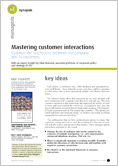Customer service: cost center or competitive advantage?

Taking the time to listen to customers may well be an effective way to identify their problems and understand their expectations better.
“Kept waiting ten minutes on the phone just to let you know I changed my address; don’t you think I have better things to do with my time?”; “I had to call back and explain the situation over and over, because I never reached the same person twice”! In every industry, statements like these are frequently heard from customers disappointed with the service of their suppliers, and the impact on brand image and customer loyalty can be disastrous.
From the company’s perspective, customer service is often perceived as a source of aggravation. “We realize that many customers want to contact us, but it’s so costly to handle all these calls that we simply can’t please everyone. Some people are inevitably going to be unhappy”, notes an executive cited in “The Best Service is No Service”. To deal with the flood of calls, focus is often placed on improving call center productivity to manage a greater volume of calls at minimum cost.
That being said, our selected authors make the basic observation that the large majority of customers don’t actually want to contact their suppliers. Ideally, they would love to use their products and services without a hitch, and never have anything to do with the firms that supply them. They attempt to contact these organizations only when absolutely obliged to do so to resolve a problem or take care of some administrative formality.
Based on this observation, three courses of action appear crucial to optimize customer service:
– Focus on reducing the number of avoidable customer service calls. Volume is not an objective! A better strategy is to concentrate on handling matters that truly require the support of the customer service department.
– When handling the remaining customer calls, focus on the root causes of dissatisfaction: lasting frustration and resentment toward the brand are all too often triggered by issues that may be relatively easy to resolve.
– Finally, look for ways to capitalize on the information collected by customer service, because this excellent market intelligence tool is rarely utilized to its full potential.
SubscriberSign in
to download
the synopse (8 p.)
VisitorI want to buy
this synopsis (8 p.)
VisitorI want
to subscribe
See also

Mastering customer interactions
More than on technologies such as the internet, call centers, CRM tools, etc., customer satisfaction depends essentially on the quality of contact with the company.

Collaborate with your customers
While the digital revolution has given consumers the possibility to involve themselves in the life of companies, very few businesses actually take advantage of this opportunity. How can you transform your consumers into privileged partners?

Support customer orientation in the field
The least qualified employees are often the ones in direct contact with customers—with a major impact on the perceived quality of service. How can you develop customer satisfaction through the engagement of your front-line employees?


